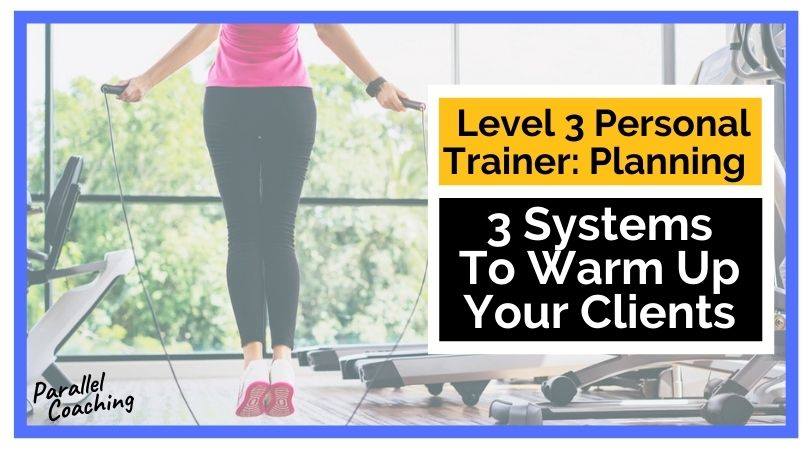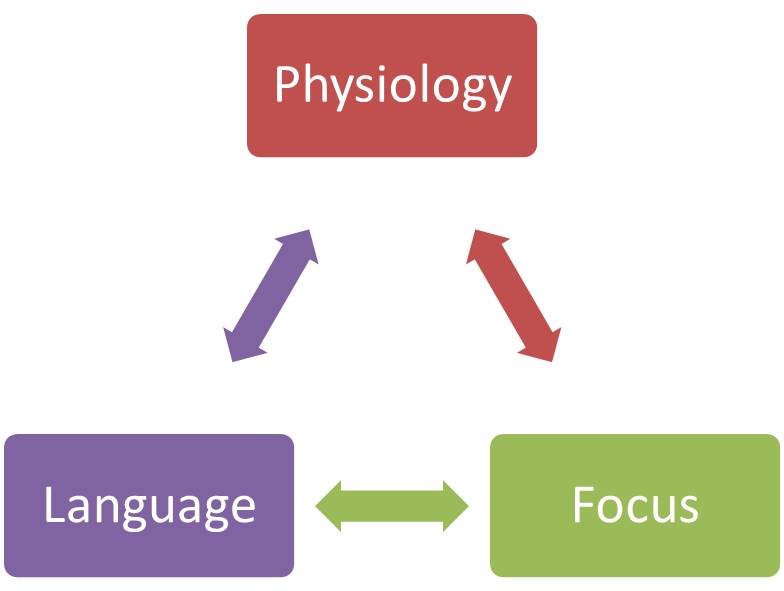In today’s blog we’ll explore the benefits of an effective warm-up on client performance and share 3 different systems to warm up your clients
You’ll discover:
- The benefits of warming up
- A simple warm up system for beginners
- An advanced RAMP warm up
- How to prepare the mind and body for the session ahead
The benefits of warming up:
Do you warm up as you start every gym session?
A well debated and controversial subject…
My second question is:
Do you think Usain Bolt or Mo Farah skip their warm-ups?
I’m guessing you said no.
We should always warm up
Would you agree that in order to warm up, you must follow a specific system that guarantees results? A result that prepares the mind and body for the session ahead without hindering the session or the goal.
We must have a system to follow to guarantee an effective start to every session.
Walking on a treadmill for 5 minutes and chucking some static stretches is no doubt a warm and what most people do. But this is a sure fire way to boredom and to be honest, not kick-starting the session effectively.
The main benefit of warming up effectively is that it prepares the mind and body for the session ahead. It reduces injury, increases body awareness, and allows us to access the energy systems required in the main session.
Today we introduce 3 warm-up systems
All 3 systems provide a clear step by step guide to warming up effectively to get the most out of every session.
MARS is suited more for beginners. Whereas RAMP was more appropriate for the more advanced person.
Notice how both systems have pretty much the same headings/features, with the main difference being stretch and potentiate. Ultimately it’s just the order in which we go through that makes the biggest difference to it being a beginner or advanced warm-up.
Warm-Up System 1: MARS
Here you steadily build up in intensity, preparing the body for the session ahead and somewhat taper intensity during the stretch. MARS is ideal for new clients that are low in confidence, motor skills and general conditioning. It allows the client to warm up, remain in control and follow a proven system.
MOBILISE: Start the session by mobilizing key joints. The aim of this is to activate the synovial joints and release synovial fluid to allow for more comfortable movement in the whole session. It is is also a great time to check client posture and coordination. We recommend 3 exercises performing just 5-8 reps on each. As an example, you could include arm circles for the shoulders, spinal rotations for the spine and marching for the hips.
ACTIVATE: Activate the client posture by setting them up in the 5-pillars neutral posture position. You can also use this time to activate muscles that are notoriously under-activated, like the glutes and core.
RAISE PULSE: Now you need to get the client physically warm using a cardiovascular exercise. You should aim to get the client’s pulse to around 40-50 % MHR, or to a 4/5 out of 10 on the RPE scale. This should be a gradual progression over approx 5 mins.
STRETCH: The stretch could be static or dynamic and should cover the entire body. Static stretching is great if the client has limited coordination or agility, if you are doing static stretches hold each stretch for 8-10 seconds as it is a static maintenance stretch. On the other hand, dynamic stretching is best for keeping the body temperature high and moving through all planes of motion. If you are doing dynamic stretching move gently through the movement with maximum control and aim to do 3-10 repetitions of each stretch.
Warm-Up System 2: RAMP
As the client continues and adheres to the plan they can soon migrate towards RAMP. By raising the pulse first, the client’s overall physiology is very different to MARS. Here the clients can rehearse key movements that are to come in that specific session and move into activation and mobility.
RAISE PULSE: Using either a single piece of CV equipment or various bodyweight exercises, get the client physically warm. You should aim to get the client’s pulse to around 40-50 % MHR, or to a 4/5 out of 10 on the RPE scale. This should be a gradual progression over approx 5 mins.
ACTIVATE: Activate the client posture by setting them up in the 5-pillars neutral posture position. You really want to focus on activating weak muscles that going to be used in the main session, you can also use this time to activate muscles that are notoriously under-activated, like the glutes and core, by using exercises like squats and lunges as well as specific exercises for the glute mediums (like a resistance band walk).
MOBILISE: You really want to focus on mobilising the key joints for that specific session. You may want to call in some dynamic stretch here to switch off any particular tight muscles.
POTENTIATE: The final part of this system is potentiate, here you want to excite the muscle and nervous system to match the intensity of the main session through controlled speed work. Ultimately you are allowing the muscles and joints to connect to the brain in a quick-fire way. What this means is greater connectivity in the session from the brain to the desired result. Which really means, you move faster, lift more and with 100% awesome technique.
Warm Up System 3: Mindset
The 3rd and final warm up system is all about mindset
A positive physiology = positive focus and language.
When you first start your session, you must change your physiology away from what you have been doing for the best part of that day. So, if you sit down at work, don’t warm up sitting down on a bike or rower. Change your physiology and I guarantee you’ll feel awesome from the outset.
Next you must focus on the session in hand, not all the other stresses of your day. Focus on the exercises, the weight, intensity, ROM and overall focus on holding the winning attitude.
You will be amazed at how much faster, fitter and stronger you feel just by focusing your attention on the ‘NOW’ and not being distracted by any other stressors.
Finally, use language that empowers you. Speak to yourself or out loud that affirms how fast, fit and strong you are or want to be. This assists in focusing your brain towards a winning attitude, breaking PB’s and achieving your session goals.
Notice how each part of this final system is all linked. You can’t just do one, you have to do all three and the results are “outstanding and you can certainly feel the difference, much more alert and focused towards the session, this will be part of every session from now on” said Matt from the personal training course.
Final tip, aim towards changing your physiology early and first up, then focus and language soon follow. It’s much easier to change someone’s physiology and build upon results early in the session compared to changing someone’s language.
A positive physiology = positive focus and language.
This impacts how you show up as a FitPro and how the client performs throughout the session.
Warm Up Mock Questions:
[NOTE: The answers are below the 3rd question]
1. Which type of stretching would be best in a warm up?
A) Dynamic Stretching
B) Developmental Stretching
C) PNF Stretching
D) Progressive Stretching
2. Why is important to raise the pulse within a warm up?
A) To stretch the tight muscles
B) To develop muscle strength
C) To prepare the muscles and the energy systems for exercise
D) To develop cardiovascular fitness
3. Which of the following is a warm up method?
A) PLUTO
B) MARS
C) SATURN
D) SUN
Answers:
Question 1= A, Question 2 = C, Question 3 = B
If you want more mock questions like this, then you can download more Free Mock Questions: DOWNLOAD NOW
Keep it simple and structured
Avoid the temptation to overcomplicate your session plans and warm-ups, a simple and structured plan is often more effective than an overcomplicated mix-match of exercises.
Our FIT-Progressions online programme details session structure, warm-ups, cool downs and how to plan for each component of fitness in order to get the best client results.
Plus you learn how to piece it all together for your L3 Personal Trainer Case study and accelerate your client journey so you can be an outstanding FITPRO.
>>>> Join us for FIT-Progressions here

Become a knowledgeable and confident FITPRO, with a clear strategy to get results with your clients every time.
There’s no more self-doubt. There’s no more guessing what to plan or how to get client results. FIT-Progressions has 8 modules and 18 video tutorials that guide you through every stage of your Level 3 Personal Trainer case study, and how to work with clients effectively.
This is for you if you’re…
- struggling to complete your coursework for PT, Yoga, or Pilates
- a newly qualified FITPRO that feels stuck or overwhelmed
- unsure where to start when planning a client session
- worrying about applying your course knowledge with a real client
- doubting you could get results and lack structure to client packages
- anxious and confused about how to get found and get busy
Click the link to find out more and join us:
https://courses.parallelcoaching.co.uk/products/fit-progressions/
Dedicated to More
Hayley “Warm Up” Bergman
Parallel Coaching
P.S. You can also find us on the following platforms:
Instagram: https://www.instagram.com/parallelcoaching
Facebook: https://www.facebook.com/ParallelCoaching
Twitter: https://twitter.com/ParallelCoach
YouTube: http://bit.ly/2F1Z1bs
Read more Planning blogs: HERE


